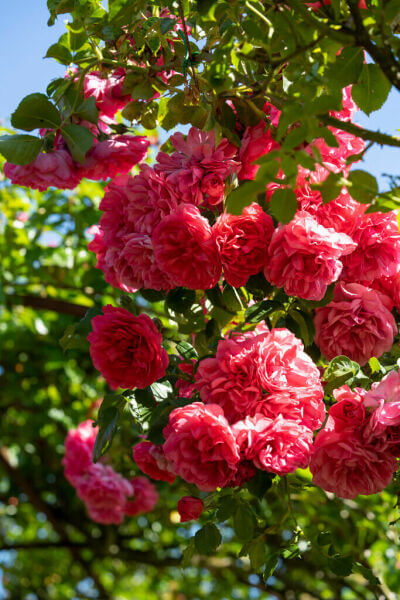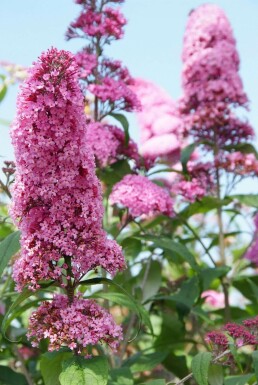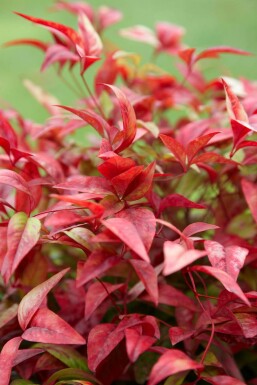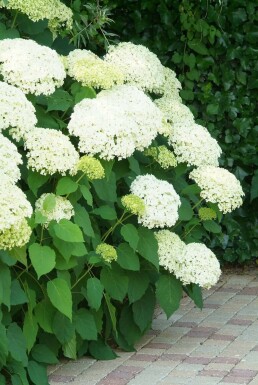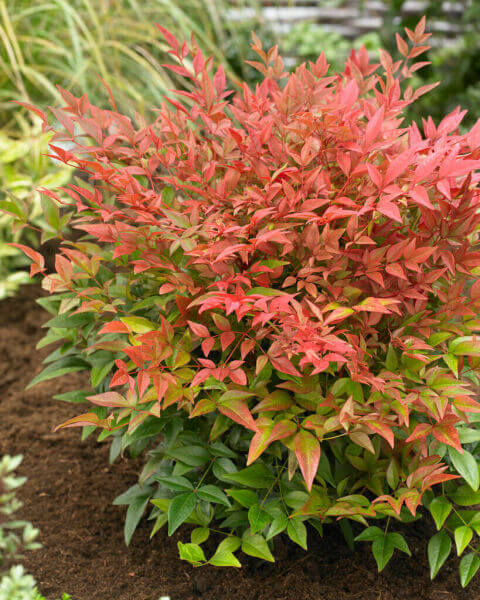 Shrubs
Shrubs
our specialists? We are happy to help you!

Shrubs
Buying shrubs can be done inexpensively online at Heijnen Plants. Check out all our varieties below, from evergreen to flowering shrubs for the garden.
Order shrubs fresh from the grower!
Want to buy shrubs online for your garden? On this page, you will find a wide range of quality shrubs all delivered directly from the nursery. Whether they are evergreen, winter hardy or flowering shrubs, Heijnen Plants will deliver them all to your home within a few working days. The great advantage of our shrubs is that they are all grown in pots. This allows shrub planting all year round (with the exception of periods of frost). Need help choosing the perfect shrub variety for your garden? Make use of the refine function on this page or contact our customer service department.
What are shrubs?
Officially, a shrub is a woody plant that branches above the ground and becomes multiple, increasingly thin branches with a mostly bushy, upright growth habit. A shrub does not form a central trunk (as a tree does, for example) and therefore grows a bit shorter than most tree species. The height of each shrub variety varies from around half a metre to about 4 metres. So there are both tall shrubs and low-growing shrubs. A shrub is therefore perfect for creating height in gardens where there is no room for a (tall) tree. A characteristic feature of shrubs is that they remain above ground even in winter and therefore maintain the structure of a garden. Some shrubs are deciduous (meaning that they shed their leaves in autumn and winter), but there are also plenty of shrub varieties that are evergreen in winter. These evergreen shrubs provide colour in the garden even during the winter months. In addition, an evergreen shrub also attracts wildlife to the garden. Birds seek shelter in it or when berries grow on it, the plant serves as a food source. The ornamental benefits of shrubs and bushes include: the shape, leaf colour, flowers, bark, autumn colour, fragrance or berries growing on the plant. The older the shrub, the more beautiful and imposing its appearance. Especially shrubs with an attractive, open growth form are therefore often used as solitary shrubs or multi-stem trees to create eye catchers in the garden, such as, Acer palmatum (Japanese maples) or Catalpa.
Using a shrub in the garden
Shrubs and trees are the backbone of a garden. They provide 'body' to the garden and come in a variety of shapes and sizes. As a result, you can find a suitable shrub for every garden. Shrubs can be divided into roughly five sub-groups, namely the deciduous, evergreen, ground-covering, berry-bearing and flowering varieties. Although it is a matter of taste, we recommend planting at least 1 evergreen shrub for every 3 deciduous shrubs (1 in 4). This at least gives you colour in the garden even in winter. Once you know which (large) shrubs you are going to place in the garden, start looking for the lower planting around them. Consider ornamental grasses, perennials or ground cover plants, for example. By staggering the flowering time, you can ensure colour and life in the garden each season. The 'refine function' on the left at the top of this page (on desktop) or filter function (on tablet/mobile) can help you with this. This feature allows anyone to easily order shrubs online. In general, shrubs are used in the garden in the following ways:
- As an eye catcher (solitary) in a border or in (small) groups together. In large gardens, shrubs like the Rhododendron, for example, can be placed together in large groups. In small gardens, plant one or a few shrubs together, surrounded by lower planting, such as border plants, ornamental grasses or ground covering plants.
- A shrub also works well as a potted or container plant on a balcony or terrace. Potted shrubs immediately add 'body' to the pot or planter and make it instantly attractive.
- Tall shrubs are also eminently suitable for creating privacy or hiding less attractive elements in the garden (e.g. the wheelie bin or compost heap). For privacy/screening purposes, we always recommend choosing evergreen shrubs.
- For attracting animals to the garden, consider shelter for hedgehogs, squirrels and birds or a food source (blueberries).
- In addition to evergreen hedges used to playfully screen a border, terrace or seating area, evergreen plants (shrubs) could also be used for this purpose. For sleek, modern gardens, people are more likely to choose a hedge. For rural or natural gardens, (evergreen) shrubs may also be perfectly suitable for this purpose (for example, Choisya ternata). This is because with an evergreen shrub, the leaves remain on the plant even in the winter months, thus maintaining privacy. Deciduous shrubs, on the other hand, shed their leaves in winter.
- At the waterside, such as a pond, river or canal. Especially shrubs with a nice growth habit (such as Cornus, for example) come into their own here.
- Some shrubs are typically associated with a certain mood or vibe in the garden. A Hibiscus (rose of Sharon), hydrangea or boxwood provide a rural feel and certain conifer, Ilex or flowering Prunus varieties provide a Japanese look and feel.
Caring for a shrub
Shrub care depends on the type of shrub. At Heijnen Plants, we state on the product page the type of care the plant needs. When planting, it is important that the soil is well turned over and that the shrub is planted in the right soil. Fortunately, most shrubs will grow in almost any soil type (although there are exceptions) and most shrubs are winter hardy in our climate. After planting, it is important to water the shrub promptly so that the plant can take root properly. Once rooted and established in the garden, the shrub only needs to be watered in prolonged drought conditions. When and how to prune a shrub varies by variety, but we also mention this on each product page. In short, you prune shrubs to maintain their shape or to remove dead, rubbing and/or diseased branches.
For most deciduous and non-deciduous (evergreen) shrubs, plants that flower in winter, spring or early summer should/can be pruned immediately after flowering (if necessary). This is because these twig and branch bloomers, as this product group is also called, bloom on twigs that were formed during the previous growing season. You can read how and when to prune shrubs on the corresponding product page. In summary, you should prune fast-growing shrubs more often than slow-growing varieties.
Shrubs that bloom in the summer and/or autumn should be pruned well in advance of the flowering period, as they bloom on new shoots. Note: do not prune these shrubs until the spring weather improves. The rule of thumb is to prune these shrubs in mid-March (this is the period when they begin to shoot again) but never at a time when it is still freezing.
Buying shrubs and bushes at Heijnen Plants
Heijnen Plants is the online garden centre for all your shrubs and bushes. All plants are delivered directly from the nursery, assuring you of the best quality. After ordering in the webshop, the shrubs will be delivered to your home within just a few working days. We pack the plants carefully so that they are delivered to your home without any loss of quality. Don't delay, order your shrubs from the webshop today.







